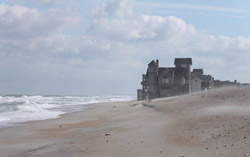Fastest Sea-Level Rise in Two Millennia Linked to Increasing Global Temperatures

Rising seas lap at the house in "Nights in Rodanthe," filmed during the field work. Credit: Andrew Kemp, Yale University<br>
The rate of sea level rise along the U.S. Atlantic coast is greater now than at any time in the past 2,000 years–and has shown a consistent link between changes in global mean surface temperature and sea level.
The findings are published this week in the journal Proceedings of the National Academy of Sciences (PNAS).
The research, funded by the National Science Foundation (NSF), was conducted by Andrew Kemp, Yale University; Benjamin Horton, University of Pennsylvania; Jeffrey Donnelly, Woods Hole Oceanographic Institution; Michael Mann, Pennsylvania State University; Martin Vermeer, Aalto University School of Engineering, Finland; and Stefan Rahmstorf, Potsdam Institute for Climate Impact Research, Germany.
“Having a detailed picture of rates of sea level change over the past two millennia provides an important context for understanding current and potential future changes,” says Paul Cutler, program director in NSF's Division of Earth Sciences.
“It's especially valuable for anticipating the evolution of coastal systems,” he says, “in which more than half the world's population now lives.”
Adds Kemp, “Scenarios of future rise are dependent on understanding the response of sea level to climate changes. Accurate estimates of past sea-level variability provide a context for such projections.”
Kemp and colleagues developed the first continuous sea-level reconstruction for the past 2,000 years, and compared variations in global temperature to changes in sea level over that time period.
The team found that sea level was relatively stable from 200 BC to 1,000 AD.
Then in the 11th century, sea level rose by about half a millimeter each year for 400 years, linked with a warm climate period known as the Medieval Climate Anomaly.
Then there was a second period of stable sea level during a cooler period called the Little Ice Age. It persisted until the late 19th century.
Since the late 19th century, sea level has risen by more than 2 millimeters per year on average, the steepest rate for more than 2,100 years.
“Sea-level rise is a potentially disastrous outcome of climate change,” says Horton, “as rising temperatures melt land-based ice, and warm ocean waters.”
To reconstruct sea level, the scientists used microfossils called foraminifera preserved in sediment cores extracted from coastal salt marshes in North Carolina. The age of the cores was estimated using radiocarbon dating and other techniques.
To test the validity of their approach, the team compared its reconstructions with tide-gauge measurements from North Carolina for the past 80 years, and global tide-gauge records for the past 300 years.
A second reconstruction from Massachusetts confirmed their findings.
The records were corrected for contributions to sea-level rise made by vertical land movements.
The reconstructed changes in sea level over the past millennium are consistent with past global temperatures, the researchers say, and can be determined using a model relating the rate of sea level rise to global temperature.
“Data from the past helped calibrate our model, and will improve sea level rise projections under scenarios of future temperature increases,” says Rahmstorf.
Support for the research also was provided by the National Oceanic and Atmospheric Administration, United States Geological Survey, the Academy of Finland, the European Science Foundation through European Cooperation in Science and Technology and the University of Pennsylvania.
Media Contacts
Cheryl Dybas, NSF (703) 292-7734 cdybas@nsf.gov
The National Science Foundation (NSF) is an independent federal agency that supports fundamental research and education across all fields of science and engineering. In fiscal year (FY) 2010, its budget is about $6.9 billion. NSF funds reach all 50 states through grants to nearly 2,000 universities and institutions. Each year, NSF receives over 45,000 competitive requests for funding, and makes over 11,500 new funding awards. NSF also awards over $400 million in professional and service contracts yearly.
Media Contact
More Information:
http://www.nsf.govAll latest news from the category: Earth Sciences
Earth Sciences (also referred to as Geosciences), which deals with basic issues surrounding our planet, plays a vital role in the area of energy and raw materials supply.
Earth Sciences comprises subjects such as geology, geography, geological informatics, paleontology, mineralogy, petrography, crystallography, geophysics, geodesy, glaciology, cartography, photogrammetry, meteorology and seismology, early-warning systems, earthquake research and polar research.
Newest articles

Recovering phosphorus from sewage sludge ash
Chemical and heat treatment of sewage sludge can recover phosphorus in a process that could help address the problem of diminishing supplies of phosphorus ores. Valuable supplies of phosphorus could…

Efficient, sustainable and cost-effective hybrid energy storage system for modern power grids
EU project HyFlow: Over three years of research, the consortium of the EU project HyFlow has successfully developed a highly efficient, sustainable, and cost-effective hybrid energy storage system (HESS) that…

After 25 years, researchers uncover genetic cause of rare neurological disease
Some families call it a trial of faith. Others just call it a curse. The progressive neurological disease known as spinocerebellar ataxia 4 (SCA4) is a rare condition, but its…





















